Multi-level storage systems aren't just an upgrade for your spring house – they're a necessity for maximizing your limited space while protecting your valuable items. You'll double or triple your storage capacity without expanding the building's footprint, leading to immediate cost savings on energy and maintenance. These systems help you maintain proper ventilation and temperature control while keeping your items organized and easily accessible. You'll benefit from enhanced safety features like proper ventilation, robust frames, and strategic access points that prevent accidents. There's much more to discover about transforming your spring house into an efficient preservation powerhouse.
Modern Space Optimization Techniques
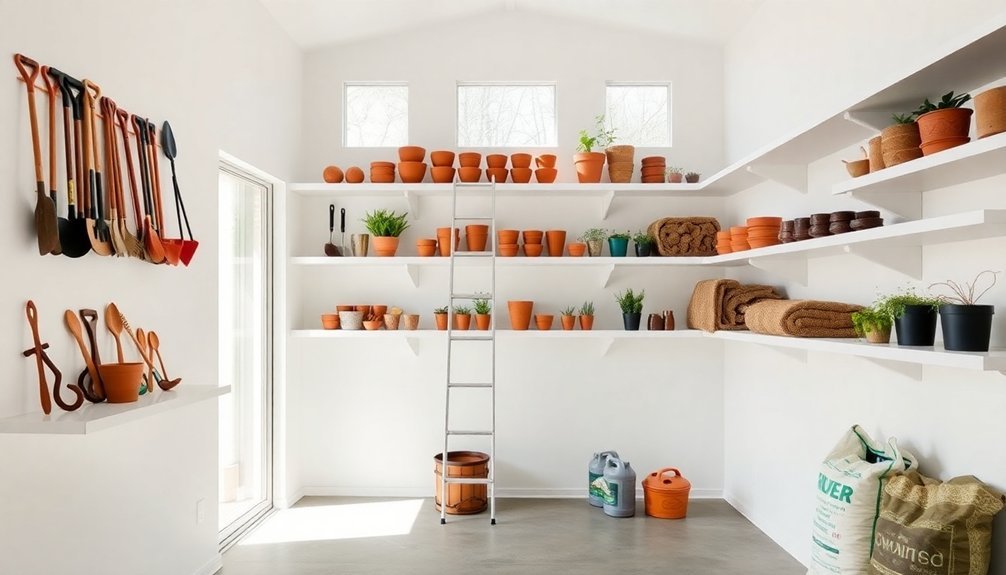
Space efficiency lies at the heart of modern storage systems for spring houses. You'll find that implementing flexible partitions creates adaptable spaces that can be quickly reconfigured to meet your changing storage needs.
By using transparent or translucent dividers, you're able to maintain privacy while maximizing natural light distribution throughout your spring house.
To optimize your available space, you'll want to focus on vertical storage solutions. Install ceiling-height shelving units and wall-mounted organizers to utilize every inch of wall space effectively. Dual-purpose furniture can maximize functionality in tight spaces.
You can double or even triple your storage capacity by implementing multi-tier shelving systems, ensuring you're making the most of both vertical and horizontal dimensions.
Smart management techniques, like the 5-S methodology, help you eliminate waste and increase efficiency.
You'll benefit from motion-sensor lighting and automated climate control systems that enhance operational efficiency while reducing energy costs.
By integrating IoT sensors and AI-driven space recommendations, you can monitor and adjust your storage configuration in real-time.
This technology-driven approach allows you to track space utilization patterns and make data-backed decisions about storage optimization, ensuring your spring house operates at peak efficiency.
Natural Cooling Performance Benefits
Building upon modern storage innovations, natural cooling performance emerges as a considerable advantage of multi-level storage systems in spring houses.
You'll find that vertical space utilization creates a more efficient environment for temperature control, while improved air circulation helps maintain consistent conditions throughout your facility. When you maximize your warehouse height instead of expanding horizontally, you're reducing the total area that requires climate control. The flexible design adaptable to various warehouse configurations helps optimize airflow patterns throughout the facility.
- Your energy consumption drops considerably as you'll need less power to maintain ideal temperatures in a vertically optimized space.
- You'll experience better air flow through well-designed multi-level systems, preventing stagnant air pockets and reducing moisture buildup.
- Your operational efficiency improves as items are stored more compactly, minimizing the time products spend exposed to varying temperatures.
The vertical arrangement of storage systems doesn't just save space – it creates a natural cooling effect by allowing warm air to rise while cooler air settles below.
This natural air circulation pattern, combined with proper system design, helps you maintain product quality while reducing your energy costs.
You'll find that the enhanced warehouse efficiency translates directly into better temperature management and reduced cooling needs.
Safety Measures for Spring Houses
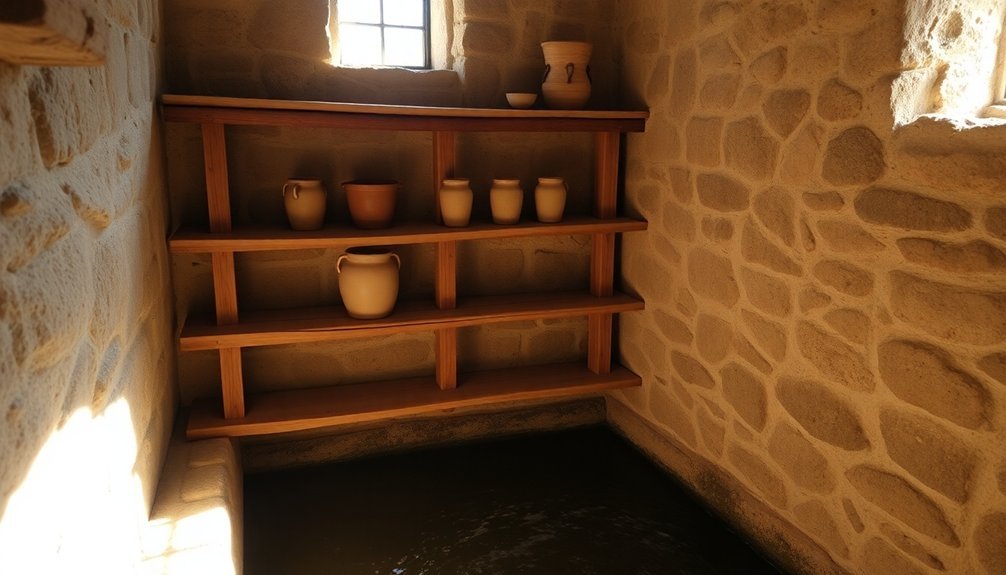
Implementing extensive safety measures stands as a critical priority when managing multi-level spring house storage systems. You'll need to focus on both product safety and physical security to maintain a safe environment.
When organizing cleaning supplies across different levels, never store bleach and ammonia products near each other to prevent accidental mixing, which can create dangerous fumes. Place warning signs nearby to remind others about potential hazards.
Ensure you're using proper ventilation throughout your spring house by installing fans and maintaining clear airflow between levels. You should wear rubber gloves and non-skid shoes while moving between floors, and keep walkways free from clutter to prevent trips and falls.
If you're lifting items between levels, remember to bend at your knees and use your leg muscles to avoid back strain.
Install smoke detectors and carbon monoxide alarms on each level, checking batteries regularly. You'll want to secure all cleaning products in cool, dry spaces away from children and pets.
Don't forget to inspect locks on all access points, including windows and doors, replacing any damaged hardware immediately. Keep bushes trimmed around your spring house's exterior to eliminate potential hiding spots and maintain clear visibility of entry points.
Customizable Storage Layout Options
Three key factors drive the design of multi-level spring house storage layouts: adaptability, vertical optimization, and efficient access.
You'll find that these systems can be customized to match your specific warehouse needs while maximizing every inch of available space. Whether you're storing medium or bulky loads, the flexible design allows you to modify and extend the system as your requirements evolve.
- You can double or triple your storage capacity by utilizing vertical space effectively, creating multiple levels of aisles without relocating your facility.
- You'll gain direct access to all unit loads through strategically placed stairs and forklift zones, making inventory management more efficient on each floor.
- Your picking operations become more streamlined as each level functions as an independent area, reducing travel time for operators.
When planning your layout, you'll need to take into account floor-to-floor heights, loading areas, and elevator placement carefully.
The system's adaptability means you can integrate automatic elements like box conveyors where needed. This flexibility guarantees your storage solution remains efficient as your spring house operations grow and change over time.
Equipment and Material Requirements
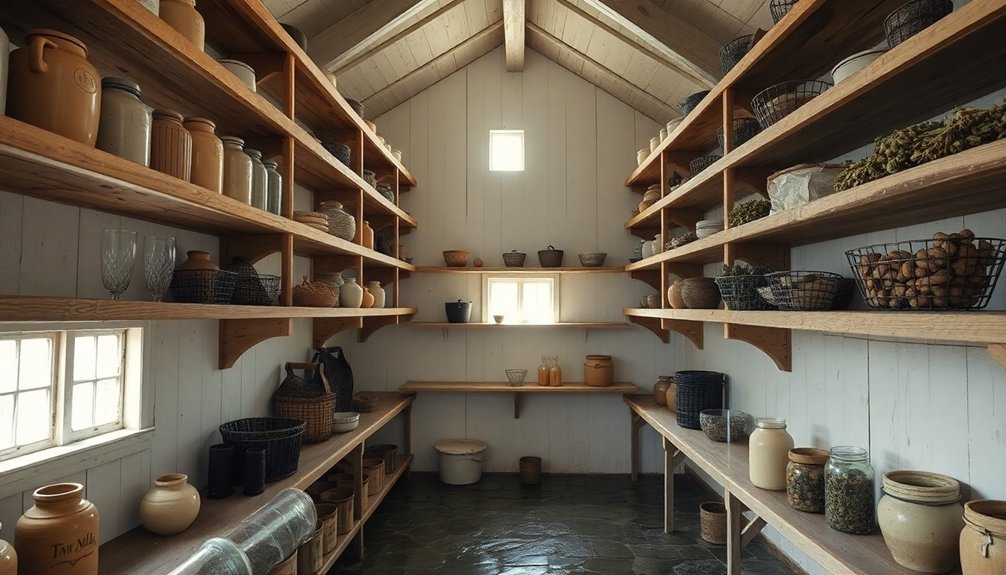
You'll need essential safety equipment, including handrails, security gates, and fall-prevention mesh, to guarantee operator protection in your multi-level spring storage system.
The core structural components consist of beams, uprights, frames, and support bars that work together to create a stable and reliable storage infrastructure.
For efficient operation, you must also incorporate proper loading tools like forklifts, along with modern warehouse management systems to optimize your picking and inventory processes.
Essential Safety Equipment Needs
Throughout any spring house storage system, safety equipment plays an essential role in protecting both your belongings and the structure itself. You'll need to integrate safety measures across all levels of your storage setup to guarantee thorough protection. This includes installing smoke and carbon monoxide detectors on every floor and implementing a reliable security system with 24/7 monitoring capabilities.
- You'll want to position smoke and CO detectors strategically throughout your spring house, particularly near sleeping areas and storage spaces. Don't forget to test them regularly and replace batteries every six months.
- It's vital to incorporate smart home security features, including cameras and water leak sensors, which you can monitor remotely through your phone or computer.
- You should maintain emergency preparedness equipment, including fireproof safes for valuable documents and a well-stocked emergency kit with flashlights, first aid supplies, and a battery-operated radio.
When setting up your storage systems, verify all electrical components are properly grounded and inspect cords regularly.
You'll also need adequate exterior lighting to maintain visibility and security around your storage areas.
Storage System Components Required
When designing a multi-level spring house storage system, proper selection of essential components guarantees structural integrity and functionality.
You'll need to start with robust frames consisting of uprights and diagonal braces, which form the backbone of your storage structure. These frames must be connected by heavy-duty beams and cross members to guarantee even load distribution and stability.
For your decking requirements, you'll want to evaluate a combination of mesh decks and steel shelves. Mesh decks provide excellent ventilation and visibility, while steel shelves offer superior strength for heavier spring components.
If you're storing smaller spring parts, MDF decks can provide a smooth, stable surface.
You'll also need to plan for efficient access throughout your system. Install stairs with appropriate handrails for personnel movement, and guarantee you have adequate space for forklift operations if you're using automated handling equipment.
Evaluate adding mezzanine safety gates at key access points to protect your staff.
Don't forget to incorporate modular components that allow for future modifications as your storage needs evolve. The entire system should be adaptable to accommodate various spring sizes and types while maximizing your available warehouse space.
Loading Tools And Machinery
A spring house's loading efficiency depends heavily on selecting the right equipment and machinery for multi-level storage operations.
You'll need to guarantee your facility has proper access mechanisms, including strategically positioned stairs and specialized forklifts designed for multi-tier environments. These tools work together to streamline your loading processes and enhance operational efficiency.
When equipping your spring house with loading machinery, consider these essential components:
- Access Equipment – Install stairs at central points or between racking structures, and deploy forklifts specifically built for multi-tier shelving to guarantee operators can efficiently reach all storage levels.
- Automated Systems – Integrate box conveyors along various levels and implement picking shuttles that are compatible with your warehouse management system to reduce manual handling and improve throughput.
- Safety Features – Equip your facility with secure racking systems that include support bars to prevent deformation, and maintain all equipment regularly to comply with National safety standards.
Your loading tools must facilitate direct access to unit loads while minimizing trips between levels.
Cost-Effective Preservation Solutions
You'll find significant cost savings by implementing multi-level storage systems that eliminate the need for costly warehouse expansions.
Your investment in vertical storage solutions maximizes every cubic foot of existing space, reducing overhead expenses while increasing storage capacity.
Smart resource allocation through efficient vertical systems helps you organize inventory more effectively, cutting down on operational costs and improving overall warehouse efficiency.
Reduced Expansion Investment Needs
Space-saving solutions in multi-level storage systems offer considerable financial advantages for spring houses by eliminating the need for costly facility expansions. By maximizing vertical space through multi-tier shelving, you'll double or triple your storage capacity without requiring additional floor space. This approach is particularly valuable when you're facing space constraints but need to increase your storage capabilities.
- You'll save considerably on construction costs by utilizing existing warehouse height instead of expanding horizontally, avoiding expenses related to new building projects or relocating to larger facilities.
- Your investment in multi-tier shelving provides immediate returns through simple, safe installation processes and reduced maintenance requirements compared to complex automated systems.
- You're getting long-term adaptability, as these systems can be modified and extended to meet your changing needs while maintaining structural integrity.
The versatility of multi-tier shelving means you can customize measurements to fit your specific spring house requirements, whether you're storing medium or bulky loads.
With evenly distributed weight across beams and support bars, you're also minimizing potential structural issues and repair costs, making this a sustainable solution for your storage needs.
Space Optimization Saves Money
Building upon the advantages of reduced expansion costs, implementing cost-effective preservation solutions through vertical storage generates considerable financial benefits for spring houses. You'll maximize your existing footprint by utilizing vertical space, increasing storage capacity by two to three times without the need for costly building expansions.
| Cost-Saving Area | Benefits |
|---|---|
| Space Utilization | Optimize existing warehouse space instead of relocating |
| Labor Efficiency | Reduce walking distances and improve picking speed |
| Infrastructure | Avoid new building construction and property costs |
Vertical storage systems let you configure shelving dimensions based on your specific needs, making the most of every cubic foot in your facility. You're able to concentrate part picking into smaller areas, which notably reduces the steps needed for order fulfillment. By keeping everything organized and properly labeled, you'll improve workflow efficiency and employee productivity, directly impacting your bottom line.
When you implement multi-level storage solutions, you're investing in a system that pays for itself through improved inventory management and increased operational efficiency. The modular and adjustable designs guarantee you can adapt to changing storage needs without additional construction costs, making it a smart long-term financial decision for your spring house.
Smart Resource Allocation Systems
Implementing smart resource allocation systems transforms how spring houses manage their storage capacity through strategic vertical organization.
You'll find that maximizing vertical space can double or triple your storage capacity without expanding your facility's footprint, leading to significant cost savings and improved operational efficiency.
These modern storage solutions offer direct access to all unit loads through strategically placed stairs and forklift-friendly designs, guaranteeing your team can quickly retrieve and store items across multiple levels:
- Customize your layout to work around existing building features like beams and columns, making the most of every available inch while maintaining compliance with safety standards.
- Position access points centrally or along the sides to optimize workflow patterns and reduce time spent moving between storage areas.
- Implement manual handling capabilities on upper levels to increase picking efficiency without requiring expensive automation systems.
Your spring house can benefit from versatile applications that accommodate various load types, from small parts to medium-sized inventory.
The system's adaptability assures you can modify and extend the storage configuration as your needs evolve, providing a future-proof solution that grows with your business.
Environmental Impact and Sustainability
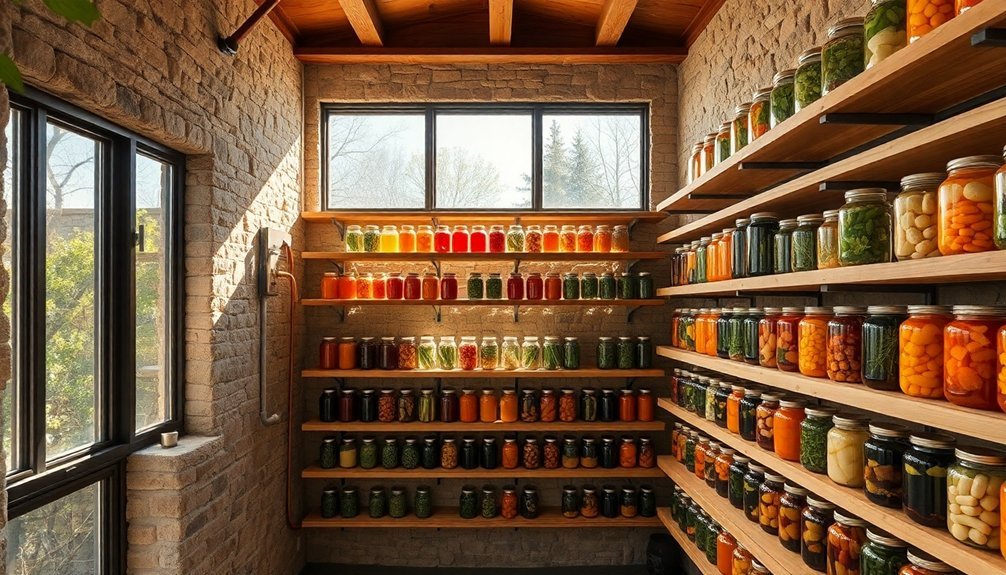
Modern spring houses with multi-level storage systems deliver considerable environmental benefits that extend far beyond efficient space utilization.
You'll find that these systems notably reduce the need for new construction, as they maximize vertical space within existing structures. This means you won't have to expand your physical infrastructure, ultimately lowering your carbon footprint and minimizing land use.
When you implement multi-level storage, you'll notice immediate energy efficiency improvements.
By optimizing vertical space, you're reducing the overall warehouse footprint, which leads to lower heating, cooling, and lighting costs. You're also cutting down on transportation emissions since you'll need fewer trips to and from storage facilities, thanks to better inventory management and streamlined operations.
You'll be pleased to know that these systems align perfectly with sustainability standards and environmental compliance.
They support your eco-friendly initiatives by promoting efficient resource use and sustainable practices. Whether you're looking to reduce your environmental impact or meet strict sustainability guidelines, multi-level storage systems offer you a practical solution that combines operational efficiency with environmental responsibility.
Frequently Asked Questions
How Long Does It Typically Take to Install a Multi-Level Storage System?
You'll typically need 5-10 hours to install a multi-level storage system. However, if you're working with larger warehouse systems or complex designs, it can take several weeks to complete the installation.
Can Existing Spring House Structures Support the Weight of Multi-Level Systems?
You'll need a professional structural assessment of your spring house first. Building supports and reinforcements may be necessary since most existing structures aren't designed to handle the significant weight of multi-level storage systems.
What Maintenance Schedule Is Recommended for Multi-Level Storage Systems?
You'll need to perform daily visual checks, weekly supervisor inspections of lower levels, and monthly thorough reviews of all levels. Don't forget quarterly load testing and annual professional assessments of your storage system.
Do Multi-Level Systems Affect the Natural Humidity Levels in Spring Houses?
No, your multi-level storage system won't affect natural humidity levels in your house. The main factors controlling humidity are external weather, internal activities like cooking, and your home's ventilation system.
Are There Specific Insurance Requirements for Spring Houses With Multi-Level Storage?
You'll need specialized insurance coverage for spring houses with multi-level storage, as standard policies often don't cover water-related risks. Be sure to declare your storage system and get specific coverage for historical structures.
In Summary
You'll find that multi-level storage systems in spring houses are essential investments for maximizing space and maintaining ideal preservation conditions. By implementing these systems, you're not only improving efficiency but also protecting your stored goods while reducing energy costs. When you consider the environmental benefits and customizable options available, it's clear that modern spring house storage solutions offer the best path forward for sustainable food preservation.

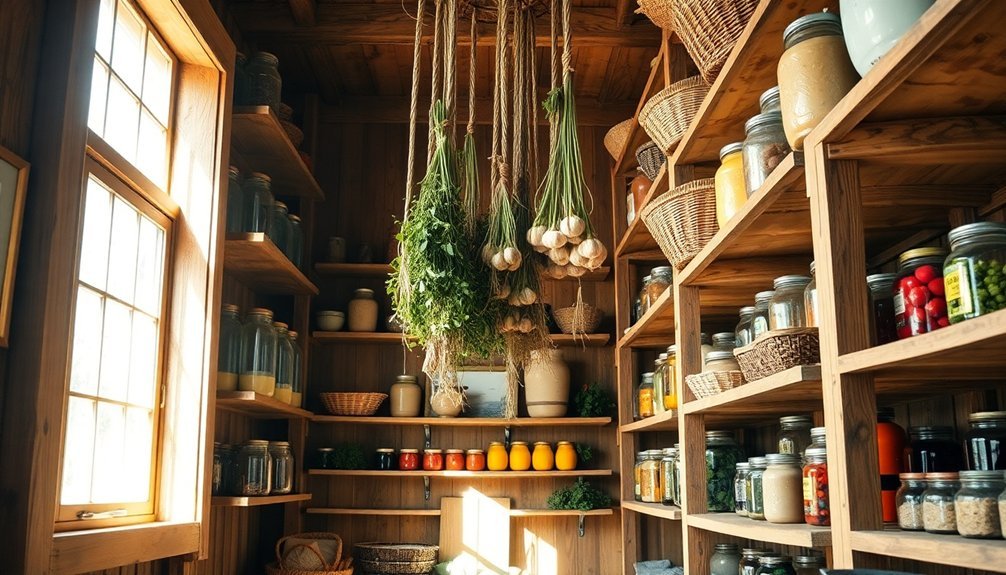



Leave a Reply